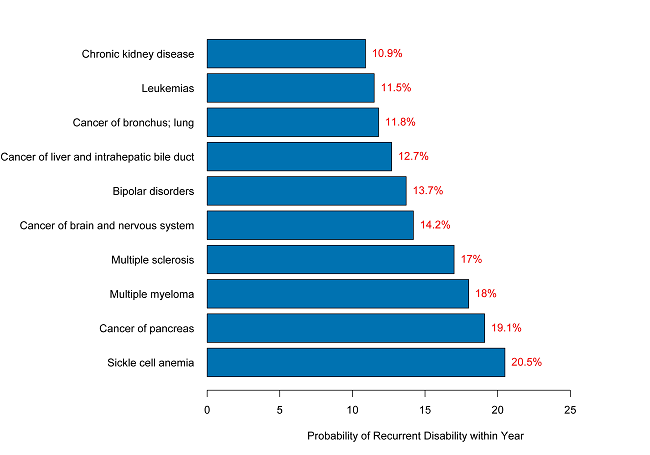The Domino Effect: Recurrent Work Disability Statistics for Chronic Conditions
 By Fraser Gaspar, PhD MPH
By Fraser Gaspar, PhD MPH
Epidemiologist
ReedGroup MDGuidelines®
Returning to activity following a disability leave is often complicated. In many instances, patients need multiple work leaves to heal or receive treatment for their medical condition. “Recurrence,” or multiple work leaves for the same or a similar medical condition, is common,1-3 and a previous disability leave is an important predictor of a future disability leave.4 Therefore, understanding recurrence patterns is essential to project and manage a patient’s full disability experience.
To my surprise, recurrent work disability statistics have never before been calculated in a U.S. population. Therefore, we recently calculated recurrence statistics and evaluated for predictors of recurrent disability to provide a better understanding of the disability experience and factors involved in the risk triage of complex cases.
Methods
Our efforts to evaluate recurrent disability were twofold: 1) calculating recurrence statistics for all chronic conditions, and 2) performing an in-depth analysis of the factors that predicted recurrent disability for common mental disorders like depressive and anxiety disorders. Both analyses used short-term disability claims in IBM MarketScan Health and Productivity Management database for the years 2007 to 2015 (more than 270,000 initial claims). We defined a recurrent disability as a disability leave occurring within one year after the initial leave with the same or similar diagnosis using the diagnosis grouper from Healthcare Cost and Utilization Project’s multi-level Clinical Classification Software.5 Our analysis on common mental disorders will be published in the open-access, peer-reviewed journal PLOS-ONE in the coming months.
Findings
Individuals whose initial leave was due to a mental disorder had the highest probability of a future disability leave within the coming year, at 7.7% of total claims. The next most common recurrent diagnostic categories were for individuals with neoplasms (6.9%) and disorders of the nervous system and sense organs (6.2%). When we looked deeper into the specific conditions with the highest probability of recurrent disability (Figure 1), we found that sickle cell anemia (20.5%) and pancreatic cancer (19.1%) topped the list. We also found that recurrent leaves were typically 10% longer than the initial leave, suggesting reduced functional capacity through time — not what we had hoped to see.
Figure 1: Top 10 Conditions with Highest Probability of Recurrent Leave in the Year After the Initial Leave

Common mental disorders that included adjustment, anxiety, bipolar, and depressive disorders had high prevalence and high recurrence probabilities. We analyzed these at greater depth. One of the most interesting findings was that individuals whose first leave was for a common mental disorder were more likely to go out on a subsequent leave unrelated to their mental disorder (Figure 2). For example, across the four mental disorders studied, the probability of a subsequent disability leave for a condition distinct from the initial leave ranged from 18.7% to 23.3%. In contrast, the probability for a subsequent leave was 9% for injuries and non-chronic disorders, and for all other chronic conditions the probability was 14.6%. While our study had an overall focus on recurrence rates at 12 months, Figure 2 includes six years of claim activity, because we found that many of these conditions did not significantly flatten until after five years.
Figure 2: Cumulative Probability of a Subsequent Leave for Patients with Common Mental Disorders vs. Other Patients

Finally, we were interested in whether we could identify which patients with mental disorders were more likely to go out on a recurrent disability leave. Using multiple variable modeling, we found that older, non-salaried employees were most at risk. Further, if an employee had a previous work leave for a non-mental health disorder (like a physical injury), they were more likely to have repeat mental health work leaves. Interestingly, employees in finance, insurance, or real estate industries were also most at risk for recurrent mental health work leaves — perhaps due to the cognitive requirements of those positions. Other significant indicators for future recurrent disability were the duration of the initial leave, and the number of outpatient psychiatric visits in the year prior to the initial leave.
Uses and Implications of Research
We developed these recurrence statistics to help disability managers estimate the probability that a patient on an initial leave for a chronic condition will experience a future leave. Empowered by this vital information, disability managers can then proactively communicate with both the employee and employer the steps that may reduce the likelihood of a subsequent leave.
Useful strategies may include an extended accommodation process once back at work, or approaches to increase adherence to the employee’s treatment regimen. Disability managers can further compare the disability durations of the initial and recurrent leaves to better understand the progression of the patient’s medical condition, disease, or injury, and set realistic expectations for employee and employer alike. In the coming months, these recurrent disability statistics will be available to all our MDGuidelines subscribers.
Our finding that the probability of subsequent disability leaves distinct from the initial disorder is higher for mental health disorders than other chronic conditions suggests that patients with mental health disorders may benefit from additional care and disability management both during and after their initial work absence. These services may include increased provider or disability management touchpoints, which may facilitate a successful and timely return to activity.
While this research highlighted some of the important factors associated with recurrent disability in mental health conditions, we plan future research to build predictive models for all chronic conditions to stratify employees most at risk for a recurrent disability leave. This model will help disability managers accurately place adequate resources on the most vulnerable claimants. We hope this research will be used to improve the continuity of care for the ever-increasing numbers of individuals with chronic disorders.
References
- Hubertsson J, M Englund, U Hallgårde, et al. Sick Leave Patterns in Common Musculoskeletal Disorders – A Study of Doctor Prescribed Sick Leave. BMC Musculoskeletal Disorders. 2014;15(1):176. doi:10.1186/1471-2474-15-176.
- Dewa CS, D Loong, S Bonato, H Hees. Incidence Rates of Sickness Absence Related to Mental Disorders: A Systematic Literature Review. BMC Public Health. 2014;14(1):205. doi:10.1186/1471-2458-14-205.
- Côté P, ML Baldwin, WG Johnson, et al. Patterns of Sick-Leave and Health Outcomes in Injured Workers with Back Pain. European Spine Journal. 2008;17(4):484-493. doi:10.1007/s00586-007-0577-6.
- Dewa CS, N Chau, S Dermer. Factors Associated with Short-Term Disability Episodes. Journal of Occupational & Environmental Medicine. 2009;51(12):1394-1402. doi:10.1097/JOM.0b013e3181bc3f7c.
- Agency for Healthcare Research and Quality. Clinical Classifications Software. Healthcare Cost and Utilization Project. 2016. Retrieved from http://www.ahrq.gov/data/hcup/



